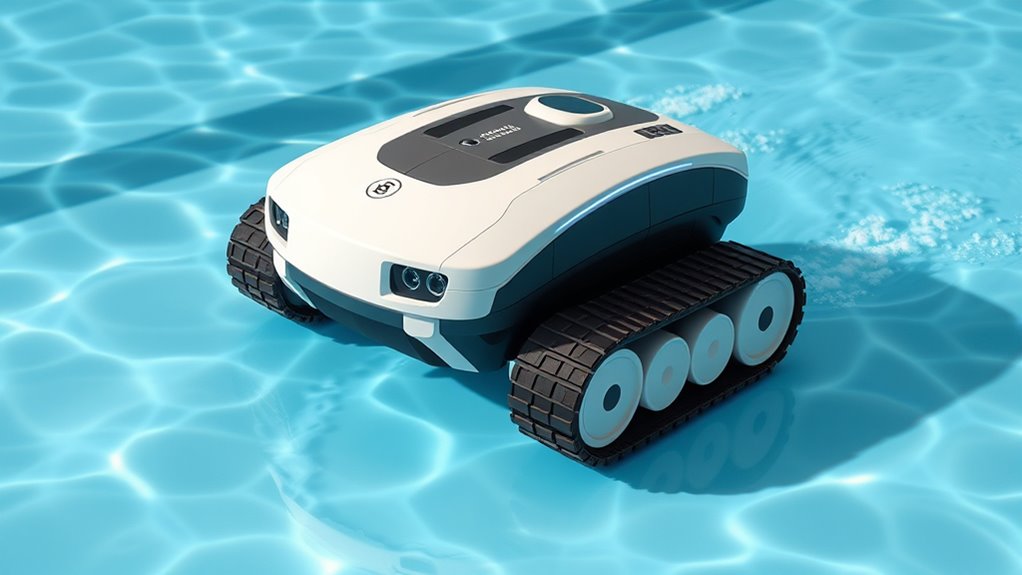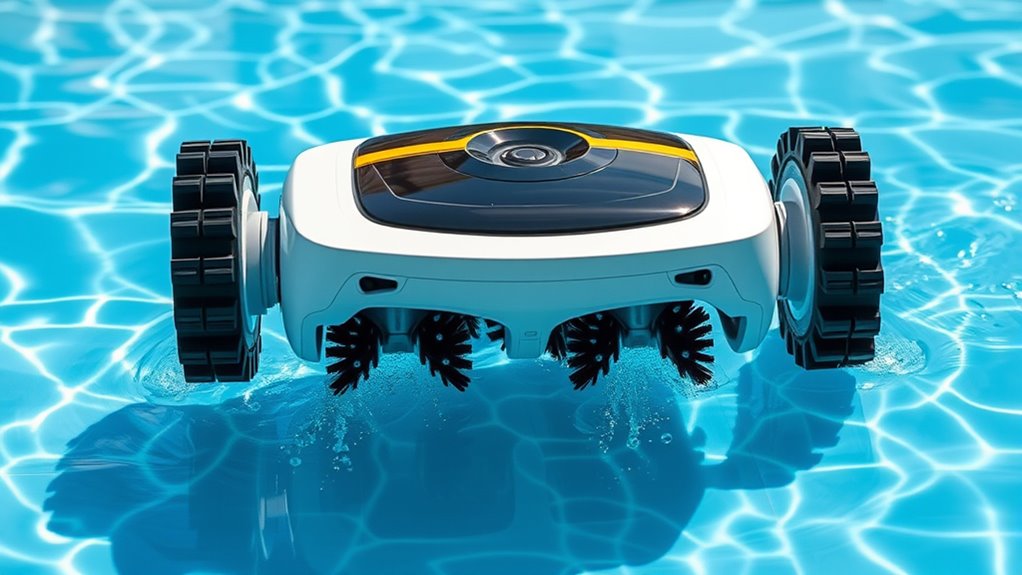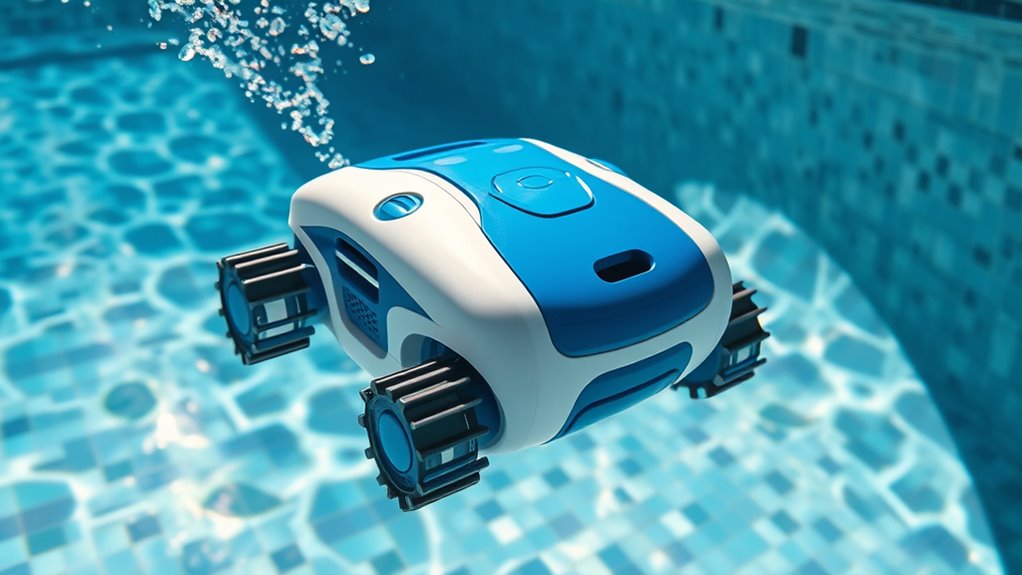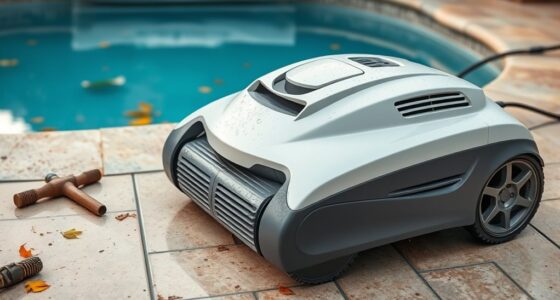Robotic pool cleaners use advanced sensors, algorithms, and onboard motors to navigate your pool efficiently. They move systematically, using brushes and vacuum systems to scrub surfaces and pick up debris. Their filters trap dirt, while rechargeable batteries power their movement and cleaning cycles. Many models include smart controls or apps for easy operation. To discover how all these components work together for a spotless pool, keep exploring the details below.
Key Takeaways
- They use onboard motors, brushes, and filters to scrub surfaces and collect debris automatically.
- Sensors and algorithms help navigate the pool, detect obstacles, and ensure systematic cleaning coverage.
- Powered by rechargeable batteries, they operate independently and return to a docking station for recharging.
- Adjustable brushes and filtration systems optimize cleaning for different pool sizes and surfaces.
- Control features like remote apps allow monitoring, scheduling, and customization of cleaning cycles.
Components and Design of Robotic Pool Cleaners

Robotic pool cleaners are equipped with a variety of components that work together to efficiently clean your pool. Their aesthetic design isn’t just about looks; it’s crafted to maximize performance and fit seamlessly into your pool environment. The outer shell typically features sleek lines and smooth surfaces, making maintenance easier and preventing debris buildup. Material durability is key—you want parts made from tough, corrosion-resistant plastics and rubber that stand up to chlorinated water and outdoor elements. Inside, you’ll find sturdy brushes, filters, and motors designed for longevity. These durable materials ensure your robotic cleaner operates smoothly over time, reducing the need for repairs. Additionally, the aesthetic design is often complemented by advanced navigation systems that allow the cleaner to maneuver efficiently around obstacles and cover the entire pool area systematically. To enhance their efficiency, many models also incorporate smart sensors that help detect dirt and guide cleaning paths more effectively. Furthermore, the integration of efficient power systems ensures these devices operate with optimal energy consumption, extending their operational lifespan. Overall, the thoughtful combination of aesthetic appeal and robust materials makes these cleaners both functional and visually appealing.
Navigation and Movement Strategies

Navigation and movement strategies are essential for ensuring your pool cleaner covers every inch effectively. These strategies allow your device to navigate around obstacles and adapt to water chemistry changes, preventing missed spots. Many robotic cleaners use algorithms that map the pool’s layout, ensuring systematic coverage. Some models incorporate sensors to detect water chemistry levels, optimizing cleaning patterns based on debris buildup or algae presence. Others use random or wall-following movements to maximize efficiency. Proper navigation reduces the need for manual intervention and helps maintain balanced pool chemicals. By intelligently moving through the water, your cleaner can target dirt without overexerting itself, preserving energy and prolonging its lifespan. Effective navigation ensures a cleaner pool, saving you time and effort.
Cleaning Mechanisms and Brushes

Cleaning mechanisms and brushes are the core components that determine how effectively your pool cleaner removes dirt and debris. The type of brushes, whether rubber or nylon, impacts how well it scrubs surfaces and picks up particles. For smaller pools, lighter brushes may suffice, but larger pools require more robust cleaning mechanisms to handle increased debris and pool chemical buildup. Your pool size influences the pressure and scrubbing power needed, ensuring thorough cleaning without damaging surfaces. The cleaning mechanism works in tandem with brushes to dislodge dirt, algae, and other contaminants. Properly designed brushes adapt to your pool’s shape and surface, maintaining efficiency across various pool sizes and chemical levels. Regular maintenance of cleaning components enhances the longevity and performance of your pool cleaner. Incorporating sensor technology helps optimize cleaning cycles and detect areas needing extra attention. Using the right glycolic acid concentration can also help prevent buildup and maintain the cleanliness of pool surfaces. Additionally, understanding the vibrational energy involved in the operation can improve your maintenance routines. Recognizing how different brush types interact with various surfaces can further improve cleaning efficiency. This combination guarantees your cleaner keeps your pool sparkling and safe.
Filtration Systems and Debris Collection

A reliable filtration system and debris collection method are essential for keeping your pool water clear and hygienic. Your robotic cleaner’s filtering efficiency ensures dirt, algae, and tiny particles are effectively captured, preventing them from recirculating in the water. These systems typically feature fine mesh filters or cartridges designed for debris separation, which trap leaves, hair, and other larger debris. As the robot moves across the pool, its filtration components continuously work to separate debris from the water, maintaining clarity and reducing the load on your pool’s main filter. Regularly cleaning or replacing these filters ensures thorough debris separation and consistent performance. Additionally, integrating AI in Business technologies can optimize the robot’s navigation and cleaning patterns for better coverage. This combination of effective filtration and debris collection keeps your pool fresh, inviting, and safe for swimmers, while filter maintenance plays a crucial role in sustaining overall performance. Proper filter cleaning methods can extend the lifespan of your filtration components and improve cleaning efficiency. Employing automated systems can further enhance the efficiency of debris removal and reduce manual upkeep. To maximize performance, it’s also beneficial to understand how the filtration systems interact with the pool’s overall water treatment process.
Power Sources and Control Features

Robotic pool cleaners rely on various power sources and control features to operate efficiently and conveniently. Most models are powered by rechargeable batteries, so understanding their battery life helps you plan cleaning sessions without interruption. A longer battery life means your cleaner can cover more area in a single run. Control features like remote control enhance usability, allowing you to start, stop, or change cleaning modes from a distance. Some advanced models also include smartphone apps for real-time monitoring and scheduling. These features give you greater flexibility and ease of use, ensuring your pool stays clean with minimal effort. Additionally, the inclusion of low light office plants can improve the overall environment around your workspace, creating a more comfortable setting for maintenance tasks. Incorporating wireless connectivity into the design of robotic pool cleaners allows for seamless integration with smart home systems, further simplifying operation. The integration of reliable power sources and intuitive control options is essential for maintaining consistent cleaning performance and user satisfaction. Moreover, understanding battery technology can help in selecting a model that offers consistent power and longevity. For example, advancements in lithium-ion batteries have significantly improved battery life and charging times. Overall, the combination of reliable power sources and intuitive control options makes robotic pool cleaners a practical choice for effortless pool maintenance.
Frequently Asked Questions
How Long Do Robotic Pool Cleaners Typically Last?
Robotic pool cleaners typically last around 3 to 5 years, depending on usage and maintenance. Battery life plays a key role; most models have rechargeable batteries lasting about 1-2 years before replacement is needed. Replacement costs can range from $50 to $150, depending on the brand and battery type. Proper care, like regular cleaning and avoiding debris overload, helps extend your cleaner’s lifespan and keeps it running efficiently longer.
Are Robotic Pool Cleaners Suitable for All Pool Sizes?
Did you know robotic pool cleaners can handle pools up to 50 feet long? They’re generally suitable for most pool sizes, but you should check the model’s pool size compatibility before buying. Installation requirements are minimal—mostly just plugging in and placing the robot in your pool. For larger or irregularly shaped pools, some models might need extra coverage or special features, so always review the specifications to guarantee a good fit.
Can Robotic Pool Cleaners Handle Algae and Tough Stains?
Robotic pool cleaners can handle algae removal and tough stain cleaning effectively. You just need to choose a model with strong scrubbing brushes and advanced filtration. These cleaners are designed to target algae buildup and stubborn stains, making your pool look fresh and clean. By operating regularly, they guarantee algae and stains don’t linger, so you enjoy a sparkling, healthy pool with minimal effort on your part.
What Maintenance Is Required for Robotic Pool Cleaners?
You need to keep your robotic pool cleaner in tip-top shape, so don’t let it slip through the cracks. Regular filter maintenance is key—clean or replace filters as recommended—and monitor the battery lifespan to guarantee peak performance. Think of it as giving your cleaner a tune-up; it’ll run smoother and last longer, saving you time and money. A little upkeep goes a long way in keeping your pool sparkling.
How Do Robotic Pool Cleaners Compare in Energy Efficiency?
Robotic pool cleaners are generally energy-efficient, consuming less energy than traditional pool cleaning methods. Their energy consumption is optimized through smart navigation and efficient motors, making them eco-friendly choices. You’ll find that many models use minimal power while effectively cleaning your pool, reducing your carbon footprint. If you prioritize eco-friendliness and want to save on energy bills, these cleaners are a smart, sustainable option for maintaining a pristine pool.
Conclusion
You might think robotic pool cleaners just zip around randomly, but their advanced navigation suggests otherwise. These cleaners often use intelligent algorithms to map your pool and optimize cleaning paths, debunking the myth that they just wander aimlessly. With their precise movement and effective brushes, they ensure thorough cleaning without manual effort. So, next time you see one in action, remember it’s not just a simple machine—it’s a smart, efficient helper designed to keep your pool pristine effortlessly.









